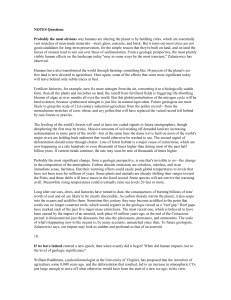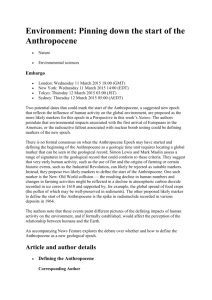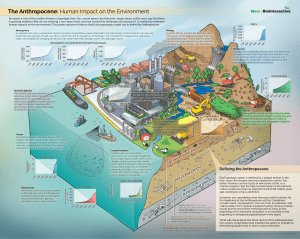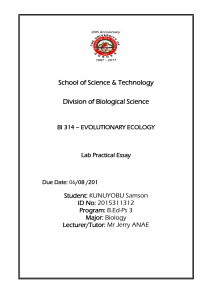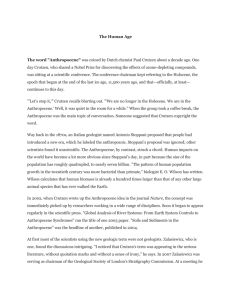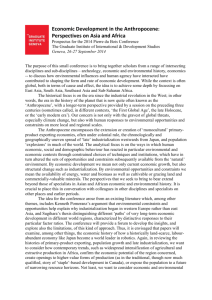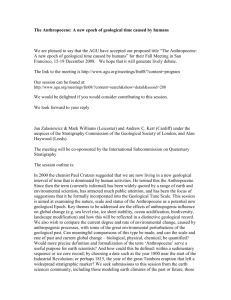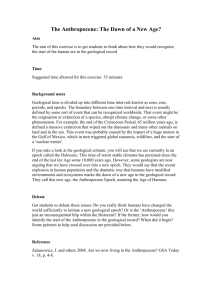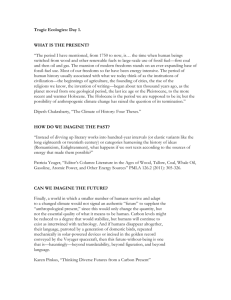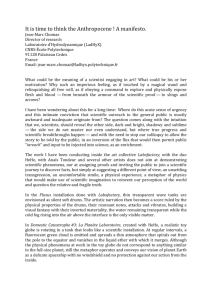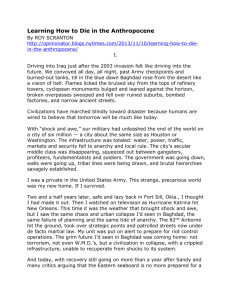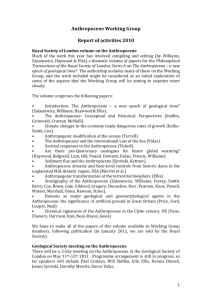The Anthropocene World History Name: E. Napp Date: Scientific and
advertisement
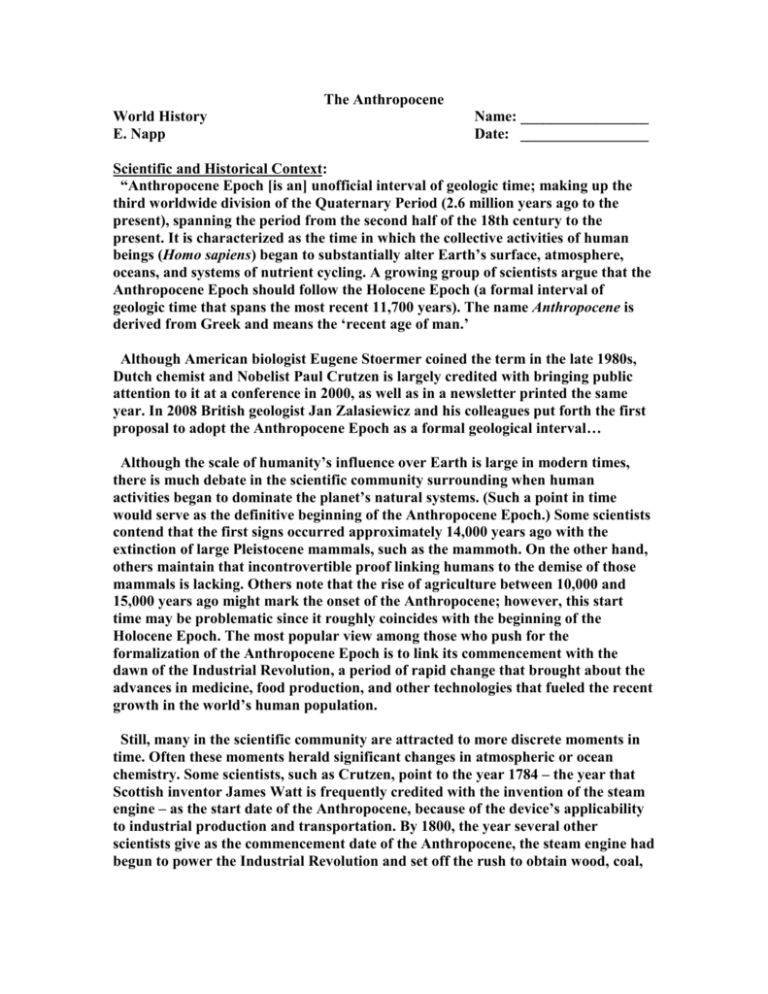
The Anthropocene World History E. Napp Name: _________________ Date: _________________ Scientific and Historical Context: “Anthropocene Epoch [is an] unofficial interval of geologic time; making up the third worldwide division of the Quaternary Period (2.6 million years ago to the present), spanning the period from the second half of the 18th century to the present. It is characterized as the time in which the collective activities of human beings (Homo sapiens) began to substantially alter Earth’s surface, atmosphere, oceans, and systems of nutrient cycling. A growing group of scientists argue that the Anthropocene Epoch should follow the Holocene Epoch (a formal interval of geologic time that spans the most recent 11,700 years). The name Anthropocene is derived from Greek and means the ‘recent age of man.’ Although American biologist Eugene Stoermer coined the term in the late 1980s, Dutch chemist and Nobelist Paul Crutzen is largely credited with bringing public attention to it at a conference in 2000, as well as in a newsletter printed the same year. In 2008 British geologist Jan Zalasiewicz and his colleagues put forth the first proposal to adopt the Anthropocene Epoch as a formal geological interval… Although the scale of humanity’s influence over Earth is large in modern times, there is much debate in the scientific community surrounding when human activities began to dominate the planet’s natural systems. (Such a point in time would serve as the definitive beginning of the Anthropocene Epoch.) Some scientists contend that the first signs occurred approximately 14,000 years ago with the extinction of large Pleistocene mammals, such as the mammoth. On the other hand, others maintain that incontrovertible proof linking humans to the demise of those mammals is lacking. Others note that the rise of agriculture between 10,000 and 15,000 years ago might mark the onset of the Anthropocene; however, this start time may be problematic since it roughly coincides with the beginning of the Holocene Epoch. The most popular view among those who push for the formalization of the Anthropocene Epoch is to link its commencement with the dawn of the Industrial Revolution, a period of rapid change that brought about the advances in medicine, food production, and other technologies that fueled the recent growth in the world’s human population. Still, many in the scientific community are attracted to more discrete moments in time. Often these moments herald significant changes in atmospheric or ocean chemistry. Some scientists, such as Crutzen, point to the year 1784 – the year that Scottish inventor James Watt is frequently credited with the invention of the steam engine – as the start date of the Anthropocene, because of the device’s applicability to industrial production and transportation. By 1800, the year several other scientists give as the commencement date of the Anthropocene, the steam engine had begun to power the Industrial Revolution and set off the rush to obtain wood, coal, and petroleum to keep both the device, as well as the rising pace of industrial production, running. Others are attracted to the year 1945, but for different reasons. In 1945 the first human-generated radioactive particles – following the testing of the first atomic bomb at Alamogordo, New Mexico, and the bombing of Hiroshima and Nagasaki, Japan – appear in the geologic record. Although radioactive particles were produced at smaller scales before 1945, it was not until that year that they occurred in amounts significant enough to appear in soil samples around the world. That same year also began what some have called the “Great Acceleration,” the postwar boom period characterized by exponential growth in the human population, fossilfuel use, water use, food production, international communication, and the pace of land-use conversion. Although some scientists argue that the Great Acceleration should be used to mark the dawn of the Anthropocene, others, including Crutzen, note that the Great Acceleration simply marked the beginning of the Epoch’s more intensive second phase.” ~ John P. Rafferty; Britannica What are the main points of the passage? 12345678910The Article: What is the Anthropocene and Are We in It? Smithsonian Magazine; January 2013, Joseph Stromberg Have human beings permanently changed the planet? That seemingly simple question has sparked a new battle between geologists and environmental advocates over what to call the time period we live in. According to the International Union of Geological Sciences (IUGS), the professional organization in charge of defining earth’s time scale, we are officially in the Holocene (“entirely recent”) epoch, which began 11,700 years ago after the last major ice age. But that label is outdated, some experts say. They argue for “Anthropocene” – from anthropo, for “man,” and cene, for “new” – because human-kind has caused mass extinctions of plant and animal species, polluted the oceans and altered the atmosphere, among other lasting impacts. Anthropocene has become an environmental buzzword ever since the atmospheric chemist and Nobel laureate Paul Crutzen popularized it in 2000. This year, the word has picked up velocity in elite science circles: It appeared in nearly 200 peerreviewed articles, the publisher Elsevier has launched a new academic journal titled Anthropocene and the IUGS convened a group of scholars to decide by 2016 whether to officially declare that the Holocene is over and the Anthropocene has begun. Many stratigraphers (scientists who study rock layers) criticize the idea, saying clear-cut evidence for a new epoch simply isn’t there. “When you start naming geologic-time terms, you need to define what exactly the boundary is, where it appears in the rock strata,” says Whitney Autin, a stratigrapher at the SUNY College of Brockport, who suggests Anthropocene is more about pop culture than hard science. The crucial question, he says, is specifying exactly when human beings began to leave their mark on the planet: The atomic era, for instance, has left traces of radiation in soils around the globe, while deeper down in the rock strata, agriculture’s signature in Europe can be detected as far back as A.D. 900. The Anthopocene, Autin says, “provides eye-catching jargon, but from the geologic side, I need the bare bones facts that fit the code.” Some Anthropocene proponents concede that difficulty. But don’t get bogged down in the mud, they say, just stipulate a date and move on. Will Steffen, who heads Australia National University’s Climate Change Institute and has written articles with Crutzen, recommends starting the epoch with the advent of the industrial revolution in the early 1800s or with the atomic age in the 1950s. Either way, he says, the new name sends a message: “[It] will be another strong reminder to the general public that we are now having undeniable impacts on the environment at the scale of the planet as a whole, so much so that a new geological epoch has begun.” To Andrew Revkin, a New York Times reporter (now blogger) who suggested a similar term in 1992 that never quite caught on (“Anthrocene”), it’s significant that the issue is being debated at all. “Two billion years ago, cyanobacteria oxygenated the atmosphere and powerfully disrupted life on earth,” he says. “But they didn’t know it. We’re the first species that’s become a planet-scale influence and is aware of that reality. That’s what distinguishes us.” What are the main points of the passage? 12345678910-
